The Effect of Domestic Sewage Treatment on Islands Using Ecological Treatment Processes: A Case Study of Haimen Island, Fujian Province
Abstract
1. Introduction
2. Materials and Methods
2.1. Experimental Location
2.2. Sewage Treatment Process
2.3. Measurement Parameters and Time
2.4. Measurement Methods
- Measurement method of CODCr: Excessive potassium dichromate solution was added to the water samples under strongly acidic solution conditions, and then heated for 2 h. The excessive potassium dichromate was dropped with ammonium ferrous sulfate solution.
- Measurement method of BOD5: The samples were cultured in a constant temperature incubator (20 ± 1 °C) for 5 days, and the dissolved oxygen concentration before and after culture was measured. The difference between the two was BOD5 value.
- The TN was measured by spectrophotometry after alkaline potassium persulfate digestion.
- The TP was measured by molybdenum antimony spectrophotometry after potassium persulfate digestion.
- NH3-N was analyzed by spectrophotometry using Nessler’s reagent;
- Water samples were filtered through a 0.45 μm filter membrane, and the filter membrane was placed on the surface of the medium. Fecal coliform was counted after 24 h of culture in the incubator at 37 °C.
- Bacteria and viruses were filtered through a 10 μm silk filter and analyzed by flow cytometry.
3. Results
3.1. Changes in Water Quality during the Commissioning Stage
3.2. Monitoring Results of Project Acceptance
3.3. Improvement of Living Environment
4. Discussion
4.1. Differences and Complementarity between the Treatment Processes of the Constructed Wetland and the Ecological Pond
4.2. Effects of Each Treatment Stage on the Abundance of Bacteria and Viruses
4.3. Characteristics of Island Sewage and Its Influence on the Treatment Process
4.4. Effects of Control Measures on Algal Blooms in Ecological Ponds
5. Conclusions
Author Contributions
Funding
Institutional Review Board Statement
Informed Consent Statement
Conflicts of Interest
References
- Rouse, J.D. Development of environmentally sustainable methods for treatment of domestic wastewater and handling of sewage sludge on Yap Island. Sustainability 2015, 7, 12452–12464. [Google Scholar] [CrossRef]
- Sun, Y.; Chen, B.; Ma, Z.; Yu, W. Assessment and cause analysis of eutrophication in the adjacent sea areas of south subtropical islands. Mar. Sci. Bull. 2010, 29, 572–576. [Google Scholar]
- Kalderis, D.; Aivalioti, M.; Gidarakos, E. Options for sustainable sewage sludge management in small wastewater treatment plants on islands: The case of Crete. Desalination 2010, 260, 211–217. [Google Scholar] [CrossRef]
- Zhao, C.; Xie, H.; Xu, J.; Zhang, J.; Liang, S.; Hao, J.; Ngo, H.; Guo, W.; Xu, X.; Wang, Q.; et al. Removal mechanisms and plant species selection by bioaccumulative factors in surface flow constructed wetlands (CWs): In the case of triclosan. Sci. Total Environ. 2016, 547, 9–16. [Google Scholar] [CrossRef]
- Jing, L.; Bai, S.; Li, Y.; Peng, Y.; Wu, C.; Liu, J.; Liu, G.; Xie, Z.; Yu, G. Dredging project caused short-term positive effects on lake ecosystem health: A five-year follow-up study at the integrated lake ecosystem level. Sci. Total Environ. 2019, 686, 753–763. [Google Scholar] [CrossRef] [PubMed]
- Jin, X.; Bi, L.; Lyu, T.; Chen, J.; Zhang, H.; Pan, G. Amphoteric starch-based bicomponent modified soil for mitigation of harmful algal blooms (HABs) with broad salinity tolerance: Flocculation, algal regrowth, and ecological safety. Water Res. 2019, 165, 115005. [Google Scholar] [CrossRef]
- Samal, K.; Kar, S.; Trivedi, S. Ecological floating bed (EFB) for decontamination of polluted water bodies: Design, mechanism and performance. J. Environ. Manag. 2019, 251, 109550. [Google Scholar] [CrossRef]
- Shahid, M.J.; Arslan, M.; Ali, S.; Siddique, M.; Afzal, M. Floating wetlands: A sustainable tool for wastewater treatment. Clean-Soil Air Water 2018, 46, 1800120. [Google Scholar] [CrossRef]
- Vymazal, J. Removal of nutrients in various types of constructed wetlands. Sci. Total Environ. 2007, 380, 48–65. [Google Scholar] [CrossRef]
- Garcia Chance, L.M.G.; Van Brunt, S.C.; Majsztrik, J.C.; White, S.A. Short- and long-term dynamics of nutrient removal in floating treatment wetlands. Water Res. 2019, 159, 153–163. [Google Scholar] [CrossRef]
- Colares, G.S.; Dell’Osbel, N.; Wiesel, P.G.; Oliveira, G.A.; Lemos, P.H.Z.; da Silva, F.P.; Lutterbeck, C.A.; Kist, L.T.; Machado, Ê.L. Floating treatment wetlands: A review and bibliometric analysis. Sci. Total Environ. 2020, 714, 136776. [Google Scholar] [CrossRef] [PubMed]
- Vymazal, J. The use constructed wetlands with horizontal sub-surface flow for various types of wastewater. Ecol. Eng. 2009, 35, 1–17. [Google Scholar] [CrossRef]
- Gao, L.; Zhou, W.; Huang, J.; He, S.; Yan, Y.; Zhu, W.; Wu, S.; Zhang, X. Nitrogen removal by the enhanced floating treatment wetlands from the secondary effluent. Bioresource Technol. 2017, 234, 243–252. [Google Scholar] [CrossRef]
- Liu, G.; He, T.; Liu, Y.; Chen, Z.; Li, L.; Huang, Q.; Xie, Z.; Xie, Y.; Wu, L.; Liu, J. Study on the purification effect of aeration-enhanced horizontal subsurface-flow constructed wetland on polluted urban river water. Environ. Sci. Pollut. Res. 2019, 26, 12867–12880. [Google Scholar] [CrossRef]
- Chen, Z.; Chen, Y.; Vymazal, J.; Kule, L.; Koželuh, M. Dynamics of chloroacetanilide herbicides in various types of mesocosm wetlands. Sci. Total Environ. 2017, 577, 386–394. [Google Scholar] [CrossRef] [PubMed]
- Jurczak, T.; Wojtal-Frankiewicz, A.; Kaczkowski, Z.; Oleksinska, Z.; Bednarek, A.; Zalewski, M. Restoration of a shady urban pond—The pros and cons. J. Environ. Manag. 2018, 217, 919–928. [Google Scholar] [CrossRef] [PubMed]
- Tanner, C.C.; Headley, T.R. Components of floating emergent macrophyte treatment wetlands influencing removal of stormwater pollutants. Ecol. Eng. 2011, 37, 474–486. [Google Scholar] [CrossRef]
- Lv, T.; Carvalho, P.N.; Zhang, L.; Zhang, Y.; Button, M.; Arias, C.A.; Weber, K.P.; Brix, H. Functionality of microbial communities in constructed wetlands used for pesticide remediation: Influence of system design and sampling strategy. Water Res. 2017, 110, 241–251. [Google Scholar] [CrossRef]
- Bankston, J.L.; Sola, D.L.; Komor, A.T.; Dwyer, D.F. Degradation of trichloroethylene in wetland microcosms containing broad-leaved cattail and eastern cottonwood. Water Res. 2002, 36, 1539–1546. [Google Scholar] [CrossRef]
- Samal, K.; Dash, R.R.; Bhunia, P. Treatment of wastewater by vermifiltration integrated with macrophyte filter: A review. J. Environ. Chem. Eng. 2017, 5, 2274–2289. [Google Scholar] [CrossRef]
- Zhu, L.; Li, Z.; Ketola, T. Biomass accumulations and nutrient uptake of plants cultivated on artificial floating beds in China’s rural area. Ecol. Eng. 2011, 37, 1460–1466. [Google Scholar] [CrossRef]
- Babatunde, A.O.; Zhao, Y.Q.; Burke, A.M.; Morris, M.A.; Hanrahan, J.P. Characterization of aluminium-based water treatment residual for potential phosphorus removal in engineered wetlands. Environ. Pollut. 2009, 157, 2830–2836. [Google Scholar] [CrossRef]
- Bi, R.; Zhou, C.; Jia, Y.; Wang, S.; Li, P.; Reichwaldt, E.S.; Liu, W. Giving waterbodies the treatment they need: A critical review of the application of constructed floating wetlands. J. Environ. Manag. 2019, 238, 484–498. [Google Scholar] [CrossRef]
- Pavlineri, N.; Skoulikidis, N.T.; Tsihrintzis, V.A. Constructed Floating Wetlands: A review of research, design, operation and management aspects, and data meta-analysis. Chem. Eng. J. 2017, 308, 1120–1132. [Google Scholar] [CrossRef]
- Samal, K.; Dash, R.R.; Bhunia, P. Design and development of a hybrid macrophyte assisted vermifilter for the treatment of dairy wastewater: A statistical and kinetic modelling approach. Sci. Total Environ. 2018, 645, 156–169. [Google Scholar] [CrossRef]
- Liu, H.; Hu, Z.; Zhang, J.; Ngo, H.H.; Guo, W.; Liang, S.; Fan, J.; Lu, S.; Wu, H. Optimizations on supply and distribution of dissolved oxygen in constructed wetlands: A review. Bioresource Technol. 2016, 214, 797–805. [Google Scholar] [CrossRef]
- Riemann, L.; Steward, G.F.; Azam, F. Dynamics of bacterial community composition and activity during a mesocosm diatom bloom. Appl. Environ. Microbi. 2000, 66, 578–587. [Google Scholar] [CrossRef]
- Bidle, K.D.; Azam, F. Accelerated dissolution of diatom silica by marine bacterial assemblages. Nature 1999, 397, 508–512. [Google Scholar] [CrossRef]
- Fuhrman, J.A. Marine viruses and their biogeochemical and ecological effects. Nature 1999, 399, 541–548. [Google Scholar] [CrossRef]
- Brussaard, C.P.D. Viral control of phytoplankton populations—A review. J. Eukaryot. Microbiol. 2004, 51, 125–138. [Google Scholar] [CrossRef]
- Zhang, X.; Fu, Y.; Fan, X.; Huang, S. The sewage of village life disposal rule and processing method research. Guangdong Agric. Sci. 2008, 8, 139–142. [Google Scholar]
- Collins, K.A.; Lawrence, T.J.; Stander, E.K.; Jontos, R.J.; Kaushal, S.S.; Newcomer, T.A.; Grimm, N.B.; Cole Ekbergh, M.L. Opportunities and challenges for managing nitrogen in urban stormwater: A review and synthesis. Ecol. Eng. 2010, 36, 1507–1519. [Google Scholar] [CrossRef]
- Tomar, P.; Suthar, S. Urban wastewater treatment using vermi-biofiltration system. Desalination 2011, 282, 95–103. [Google Scholar] [CrossRef]
- Ye, J.; Xu, Z.; Chen, H.; Wang, L.; Benoit, G. Reduction of clog matter in constructed wetlands by metabolism of Eisenia foetida: Process and modeling. Environ. Pollut. 2018, 238, 803–811. [Google Scholar] [CrossRef]
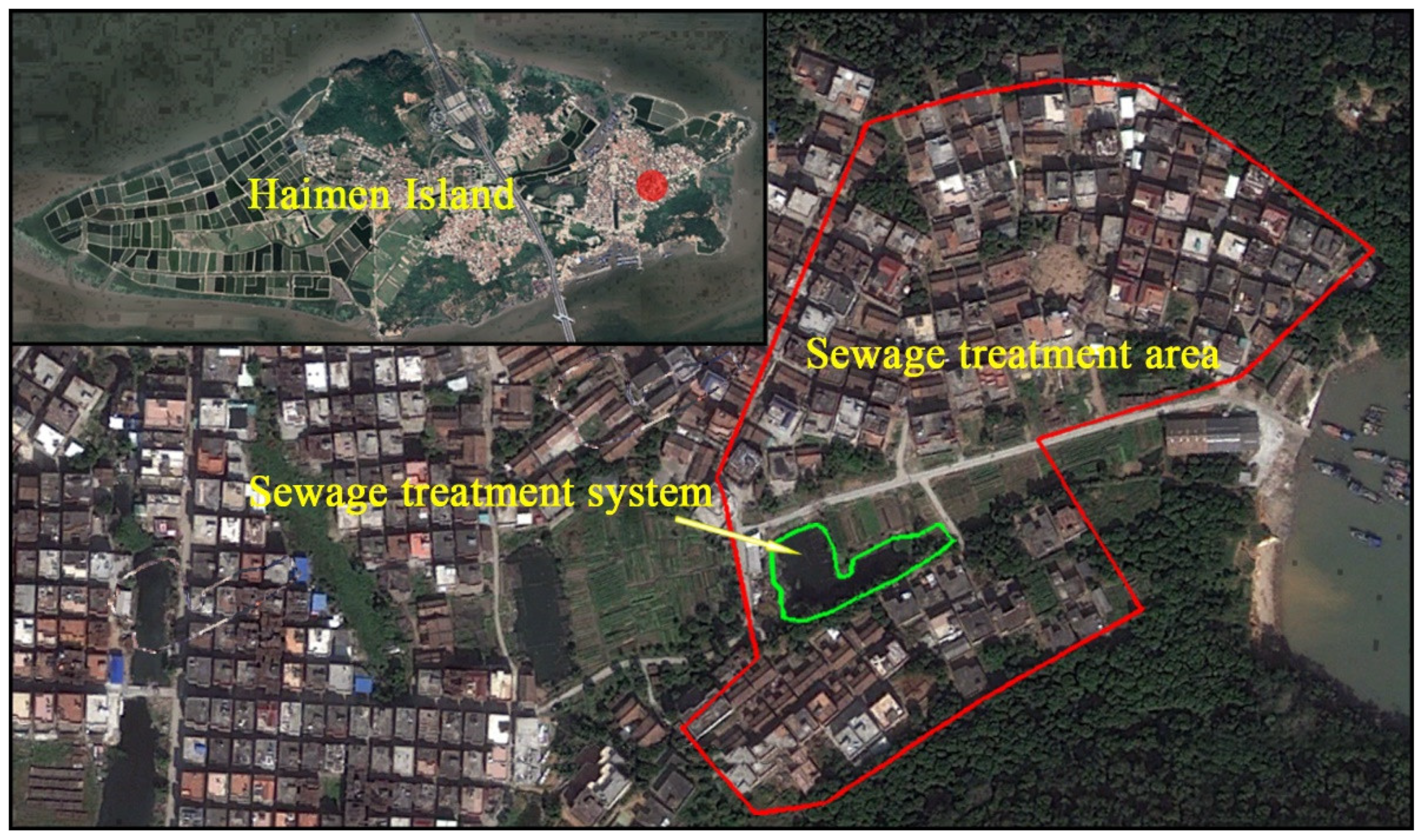

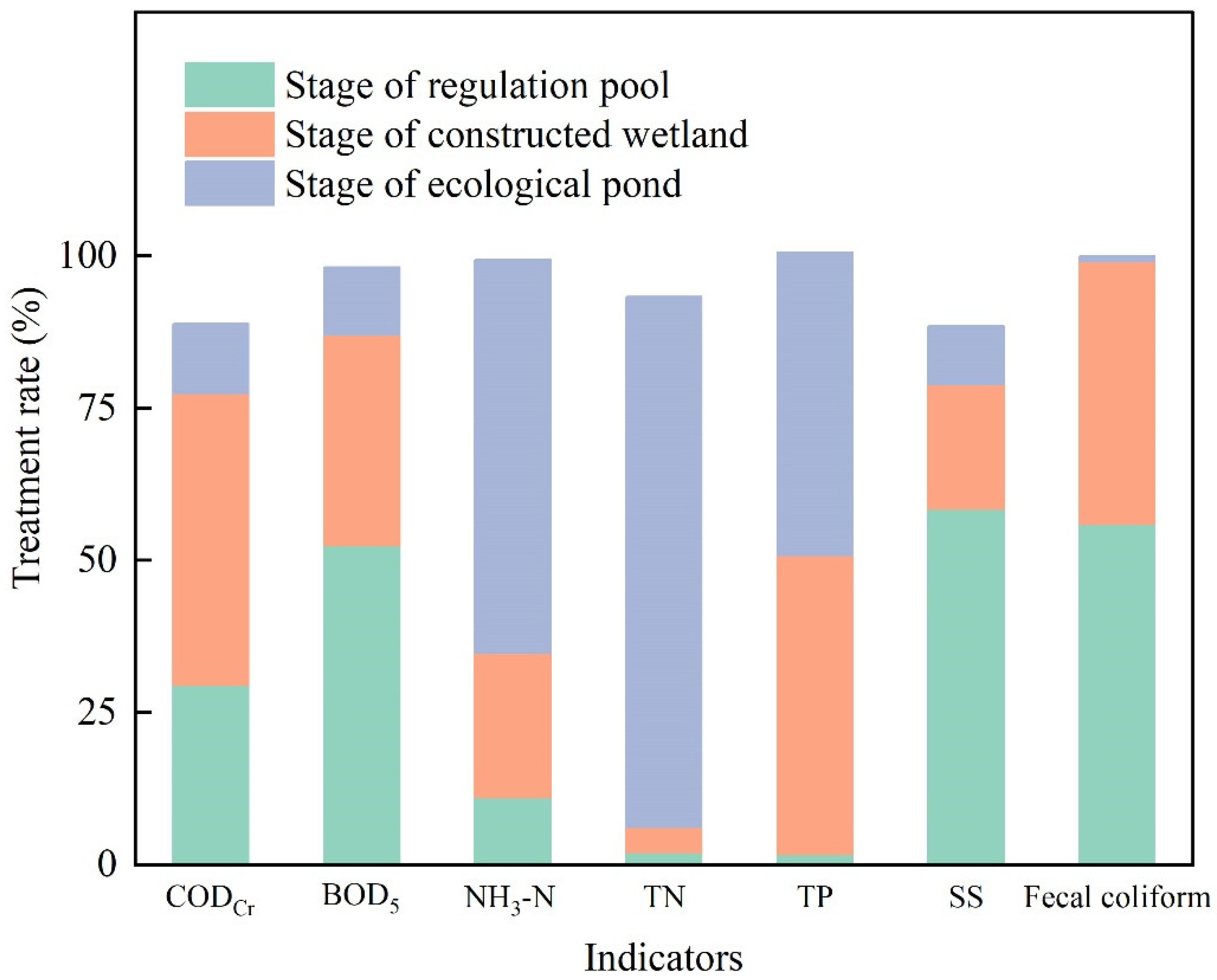

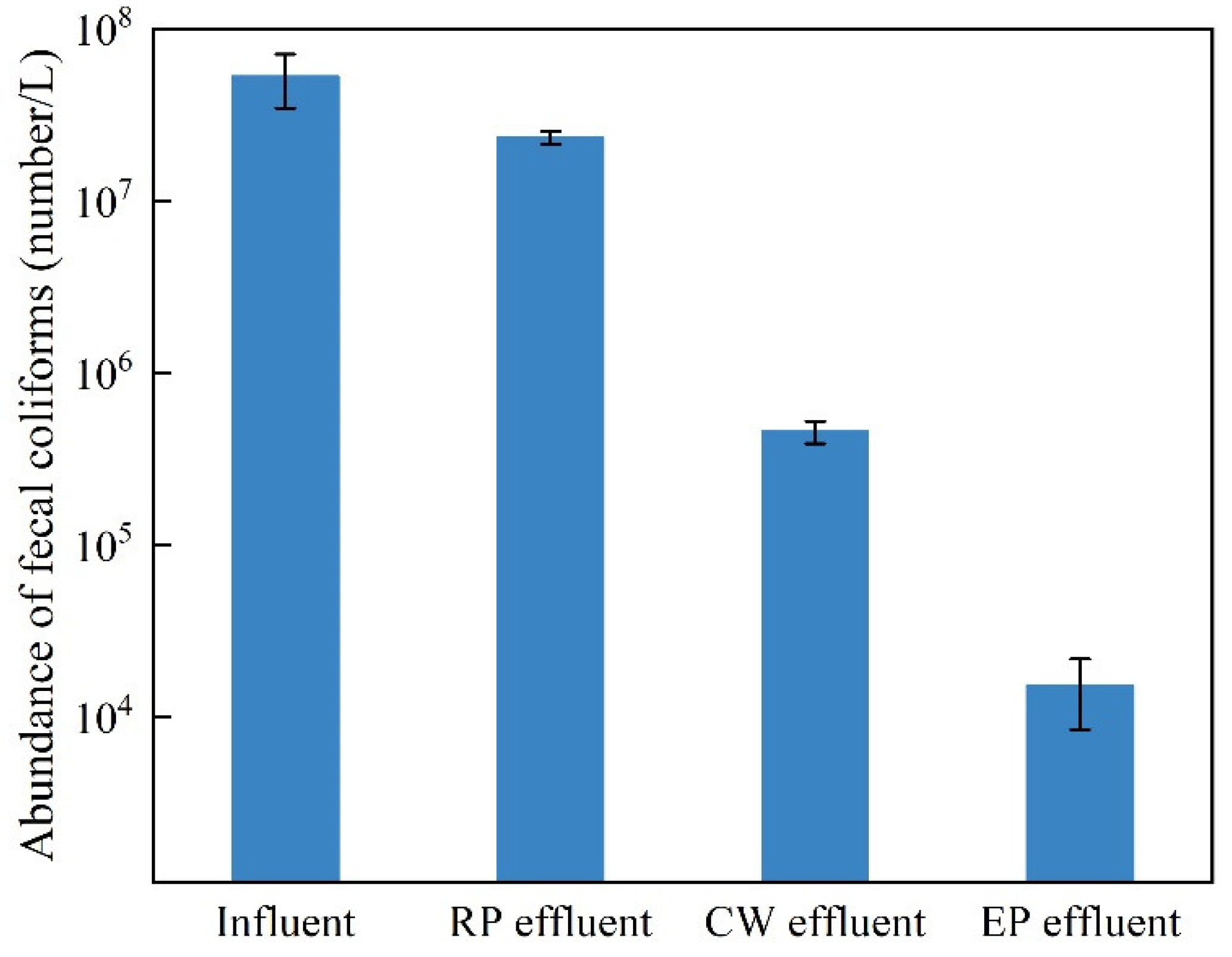
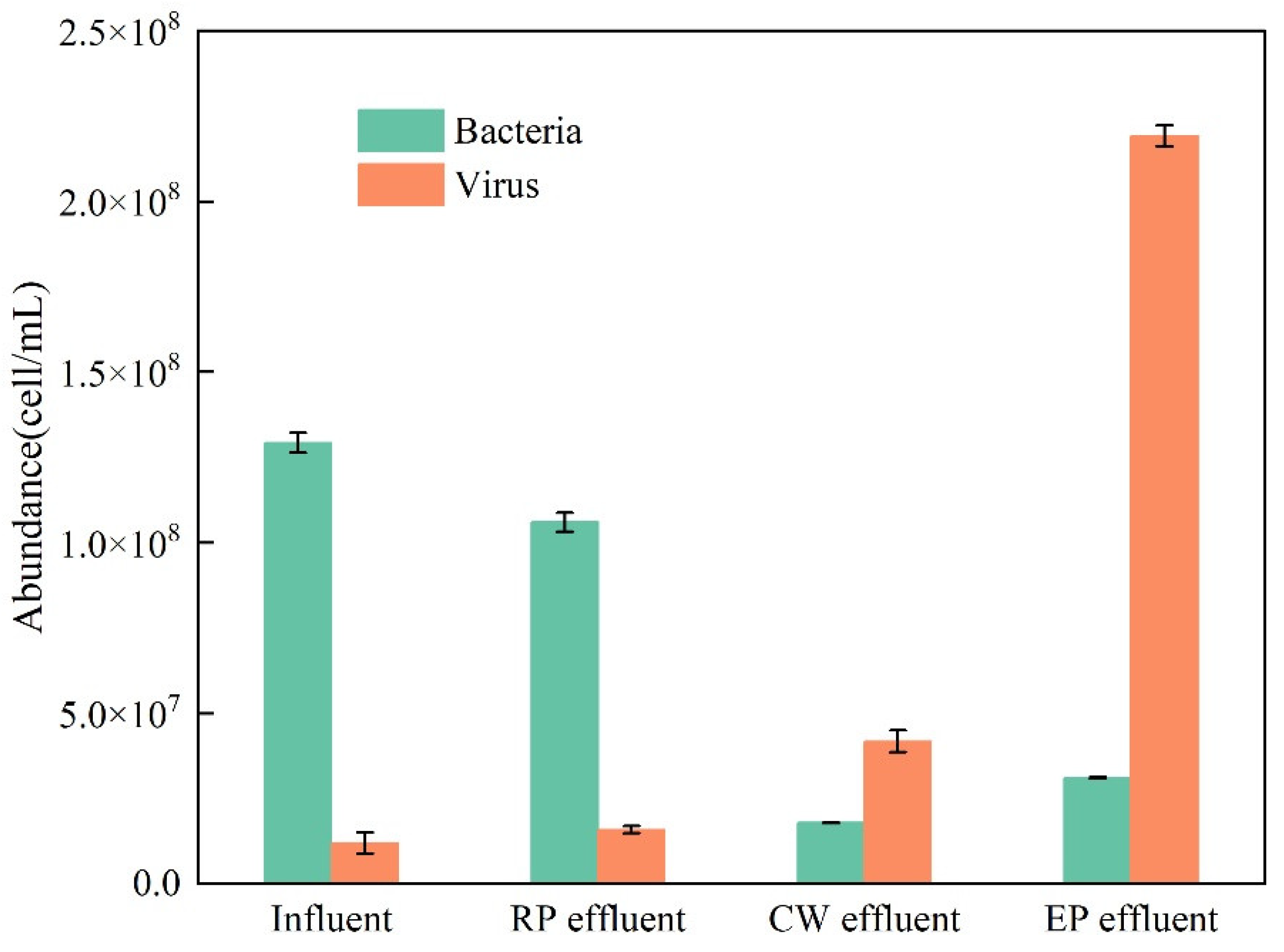
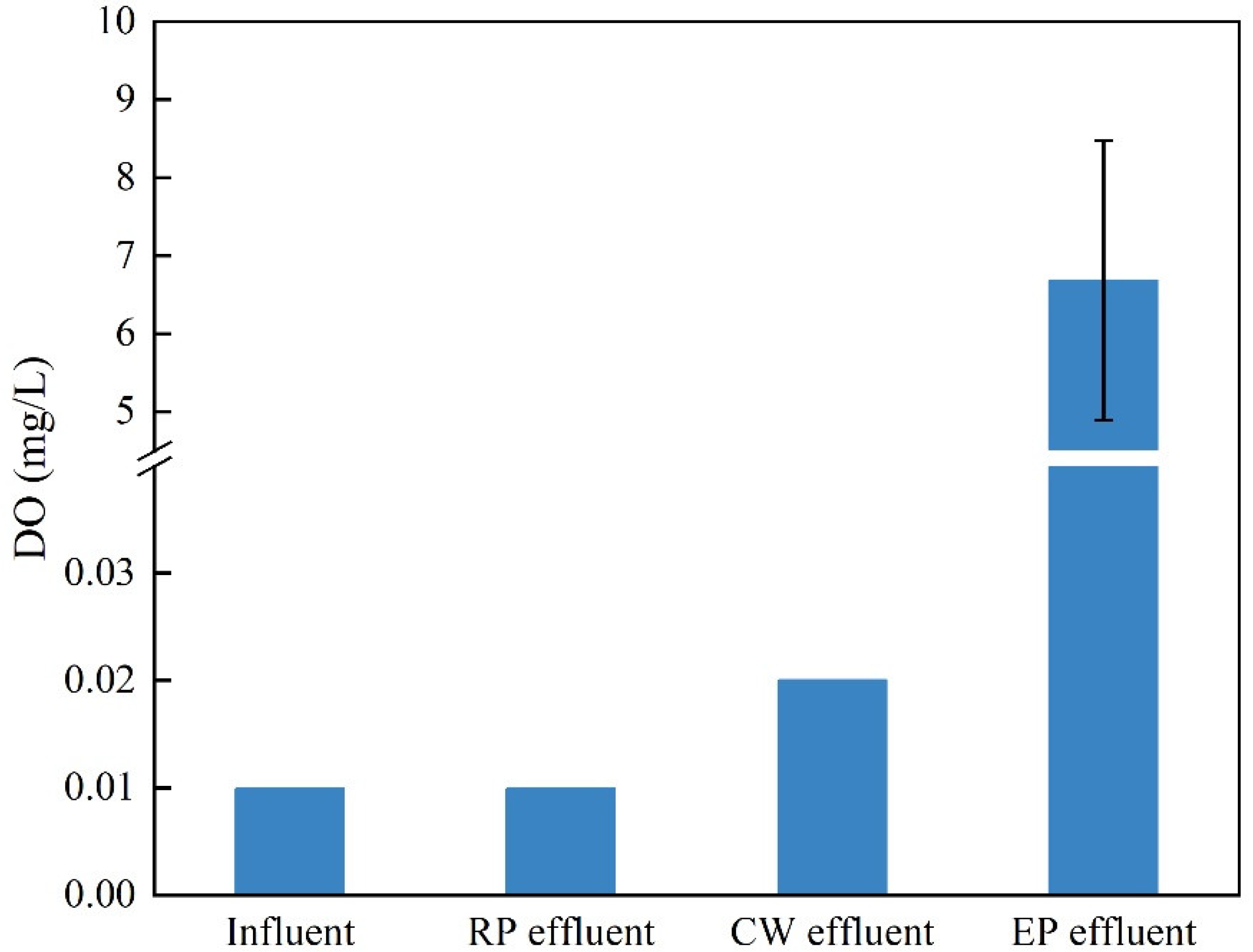
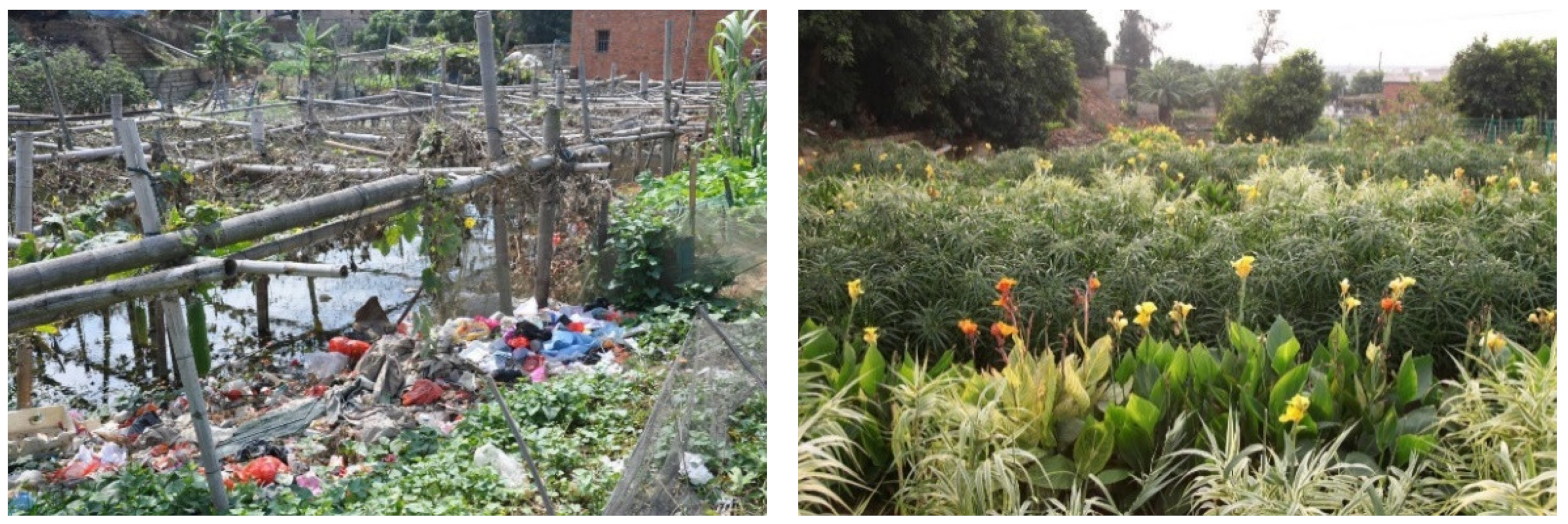
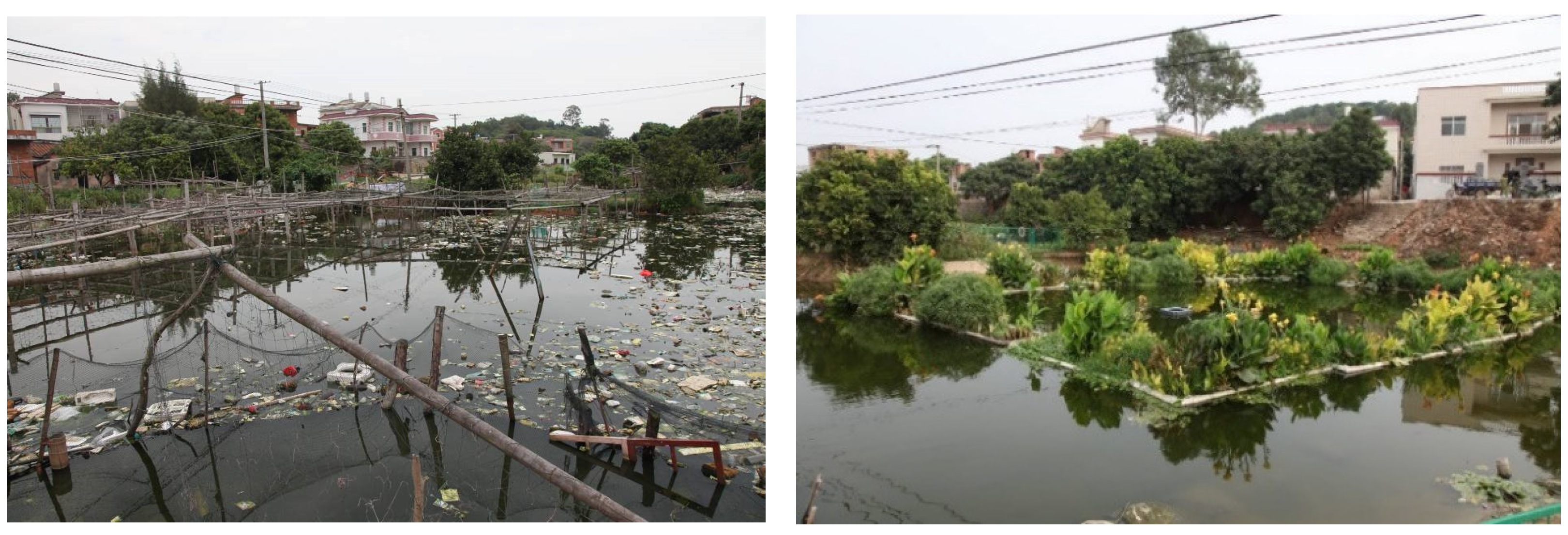
| Date | Influent | RP Effluent | CW Effluent | EP Effluent | ||||
|---|---|---|---|---|---|---|---|---|
| CODCr | NH3-N | CODCr | NH3-N | CODCr | NH3-N | CODCr | NH3-N | |
| 22 June | 390.2 | 128.1 | 280.4 | 97.5 | 128.3 | 38.5 | 87.6 | 9.1 |
| 16 July | 374.4 | 143.5 | 317.6 | 122.3 | 148.6 | 63.2 | 67.3 | 15.7 |
| 21 August | 204.2 | 76.6 | 162.7 | 52.9 | 81.3 | 31.1 | 69.8 | 16.2 |
| 28 August | 192.1 | 68.7 | 172.5 | 57.3 | 87.3 | 37.4 | 60.2 | 8.6 |
| Sample | CODCr (mg/L) | BOD5 (mg/L) | NH3-N (mg/L) | TN (mg/L) | TP (mg/L) | SS (mg/L) | Fecal coliform (Number/L) |
|---|---|---|---|---|---|---|---|
| Influent | 508.0 | 240.0 | 209.0 | 259.50 | 18.48 | 138.5 | 5.29 × 107 |
| RP effluent | 358.0 | 114 | 185.75 | 254.25 | 18.15 | 57.5 | 2.33 × 107 |
| CW effluent | 114.5 | 31 | 136.25 | 243.5 | 9.58 | 29.25 | 4.55 × 105 |
| EP effluent | 56.5 | 4.55 | 1.22 | 17.45 | 0.88 | 16.0 | 1.51 × 104 |
| Standard I B (GB18918-2002) | 60 | 20 | 8 | 20 | 1 | 20 | 104 |
Publisher’s Note: MDPI stays neutral with regard to jurisdictional claims in published maps and institutional affiliations. |
© 2022 by the authors. Licensee MDPI, Basel, Switzerland. This article is an open access article distributed under the terms and conditions of the Creative Commons Attribution (CC BY) license (https://creativecommons.org/licenses/by/4.0/).
Share and Cite
Sun, Y.; Tang, K.; Song, H.; Jiang, D.; Chen, S.; Tu, W.; Cai, L.; Huang, H.; Zhang, F. The Effect of Domestic Sewage Treatment on Islands Using Ecological Treatment Processes: A Case Study of Haimen Island, Fujian Province. Int. J. Environ. Res. Public Health 2022, 19, 15440. https://doi.org/10.3390/ijerph192315440
Sun Y, Tang K, Song H, Jiang D, Chen S, Tu W, Cai L, Huang H, Zhang F. The Effect of Domestic Sewage Treatment on Islands Using Ecological Treatment Processes: A Case Study of Haimen Island, Fujian Province. International Journal of Environmental Research and Public Health. 2022; 19(23):15440. https://doi.org/10.3390/ijerph192315440
Chicago/Turabian StyleSun, Yuanmin, Kunxian Tang, Hui Song, Degang Jiang, Shan Chen, Wulin Tu, Luchun Cai, Haiping Huang, and Fei Zhang. 2022. "The Effect of Domestic Sewage Treatment on Islands Using Ecological Treatment Processes: A Case Study of Haimen Island, Fujian Province" International Journal of Environmental Research and Public Health 19, no. 23: 15440. https://doi.org/10.3390/ijerph192315440
APA StyleSun, Y., Tang, K., Song, H., Jiang, D., Chen, S., Tu, W., Cai, L., Huang, H., & Zhang, F. (2022). The Effect of Domestic Sewage Treatment on Islands Using Ecological Treatment Processes: A Case Study of Haimen Island, Fujian Province. International Journal of Environmental Research and Public Health, 19(23), 15440. https://doi.org/10.3390/ijerph192315440






